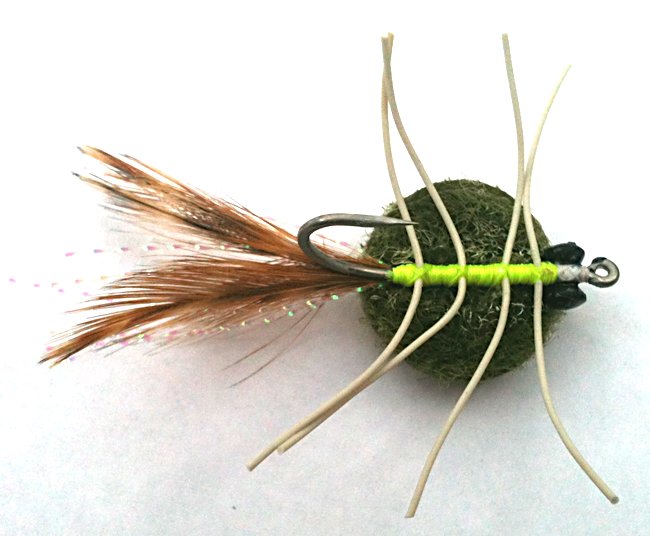Del Brown's Merkin style Olive Crab Fly
The Olive Merkin fly developed by Del Brown is one of the best patterns for Permit. Crabs near Mangrove swamps and weed beds have olive shells. (Some say that Jan Isley was the real originator of this style of crab fly with the design of the Isley Crab fly but it is more commonly known as the Dell Brown's Merkin Fly). Our version uses an olive felt disc instead of wool which we found can go out of shape.

INVERTED HOOK CRAB PATTERNS. Hook size 6 & 4 - $US each
Fly fishing for Permit is so difficult that the number caught is far lower than other species. Del Brown, an expert permit flyfisher, over a 20 year period, fishing 100 days of each year has only caught just over 500 Permit fish. These fish are hard to catch. If a permit is feeding in shallow water – particularly with its head down and tail up – cast the crab fly as close as possible to the fish. If the fish ignore it and begins to move away, twitch the fly slightly. Strip it and then let it drop to the bottom. The ‘no’ retrieve at this point is the best tactic. Even more important than which fly is on your leader is how it is moving when a permit sees it. A crab in the presence of a permit wants one thing: the cover of the bottom. Crabs use camouflage to escape predators and often sit motionless to avoid becoming some fish’s lunch.
The Merkin crab pattern is designed to drop to the bottom trailing its claws. It can only do this if you are not stripping the line. You must let the fly fall as the Permit sees it. A grazing Permit is focused on a small area in front of its face, which gives you a very small target. What makes fishing for Permit tough is that a cast aggressive enough to hit this tiny target area will often spook the fish. A cast that lands outside the Permit’s range of attention can still be effective, but you will have to twitch the crab pattern and hope the Permit sees the movement in its peripheral vision. Just after you cast you can make one initial strip to get the permit to see the fly, and then let it drop. Ideally the fish then races over and tips up. You can sometimes see the fish open its pink lips and suck in the fly. You must strip-strike with your left hand, not with the rod tip. A smooth steady strip of the line followed by a small tug when the line comes tight will set the hook. If you have missed the strike, the crab jumps a foot and drops to the bottom. There is a good chance the fish will pounce on it again. If your cast has a lot of slack in it and you are stripping to get the slack out, you are still moving the fly, and the permit will most likely spook.
You make a long smooth strip-strike with your rod pointed directly at the fish. The line comes tight and the Permit races off. Let the line slide through your left hand with slight pressure to get the fish onto your reel. As the permit sails into your backing and nears the end of its first run, lean your rod over to turn the fish with steady pressure. It turns and gain line. Immediately lean your rod back over and try to turn it the other way. This will continue for some time. Expect another good run when the fish sees the boat. Put as much constant pressure on the permit as you can. You must work with him and ease the fish over the mouth of the net.

